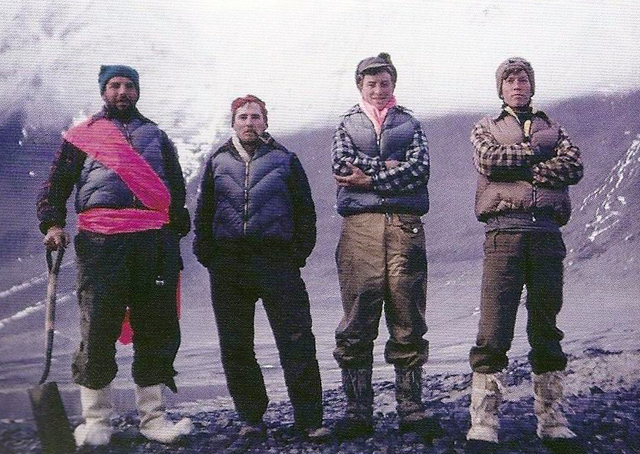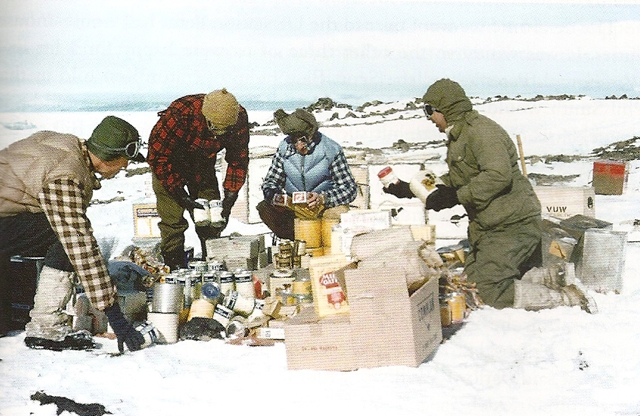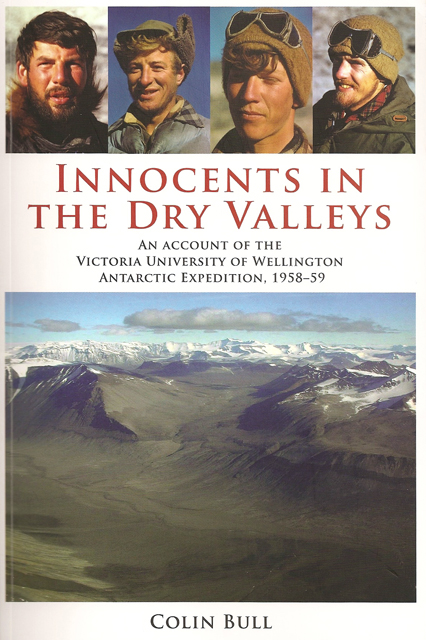Groundbreaking studyNew book details first university-sponsored expedition to AntarcticaPosted January 8, 2010
It took Colin Bull 50 years before he published an account of his first Antarctic expedition, a groundbreaking study of the McMurdo Dry Valleys Filled with Bull’s droll sense of humor and wry observations, Innocents in the Dry Valleys (Victoria University Press, 2009) tells the story of the first university-sponsored science party from Victoria University of Wellington in New Zealand. Related story
The four-man team — three New Zealanders and the Britain-born Bull — became the first humans to tramp across much of the Wright Valley, forging a friendship that survives to this day. A 30-year-old, ambitious geophysicist in 1958, Bull pulled off the venture with a shoestring budget, along with a little bit of luck and audacity along the way. Why did it take him five decades to write the story? “Look, I was busy,” he deadpans, during a phone interview from his home on Bainbridge Island, Wash. “I had always intended to write the [darn] thing up, but something always got in the way — like work.” The experience from that two-month adventure led him to The Ohio State University (OSU) Since then, Bull, 81, has largely devoted himself to writing, collecting and selling books on polar history. His first book was a biography, Silas: The Antarctic Diaries of Charles S. Wright, which was published in 1993. The second, Innocents in the Arctic, was an account of his first polar adventure — a geological expedition to Spitsbergen in the high arctic for 12 weeks with fellow graduate students in 1951. The 10 students originally tried to sail for the Norwegian island in a wooden World War II motor-launch, but the vessel was deemed unfit, so they hitched a ride in a coal boat. The young team eventually worked its way inland from the coast, surveying and sampling areas no one had been to before. The group met regularly over the succeeding years, and on the 40th anniversary of that expedition, they all agreed it would be wonderful to write a book about the adventure. And they all agreed Bull would be the best person for the job, since he was the only one who hadn’t kept a diary during the trip. “This was an experiment on my part to see if it was necessary to write a diary in order to be able to remember,” he explains. What were the results? “It helps [to write it down]. It certainly helps,” he admits. For his first Antarctic venture, Bull didn’t make the same mistake. “I wrote a very, very long letter to Gillian, my wife. It was very, very detailed — it was as detailed as I could make it.” He supplemented his letter diary for the book with input from his three compatriots — Dick Barwick, Barrie McKelvey and Peter Webb. Barwick was the biologist on the expedition, about a year younger than Bull. McKelvey and Webb were undergraduate geology students in their early 20s who would go on to be some of the leading polar scientists of their time. “It really was a very significant event in everybody’s life,” Bull notes. “Peter and Barrie have done more in Antarctic geology than any people I know.” Meanwhile, at age 80, Barwick continues fieldwork in Australia related to studying the fossils of ancient fish. Bull showed the first draft of the book to his friends during yet a different reunion of old colleagues. Later, Barwick sent Bull his own diary of the Dry Valleys expedition, which convinced the polar historian he needed to do a rewrite. “I had spent 52 consecutive nights in the same tent as Dick. We ate the same food, pulled the same sleds, and we climbed the same stupid, bloody hills,” Bull says. “Dick had kept a very complete diary … It was obvious reading through Dick’s diary that we had been on the same expedition but that was the only similarity.” Much of the action in Innocents in the Dry Valleys follows the literal ups and down of Bull and Barwick as they traverse across the ice-free valley that holds Lake Vanda and Antarctica’s longest stream, the Onyx River, which Bull named. McKelvey and Webb teamed up to explore and sample the region’s geology — and, as Bull tells it, set some sort of record for sheer volume of food consumed in one field season that may still stand today. Indeed, much of the story is occupied with the day-to-day hungers and hardships of working in Antarctica’s backcountry. Bull’s self-deprecating humor often turns on his own layer of “subcutaneous fat” that slowed his slogs up unnamed hills. After the U.S. Navy transported the four scientists to the Dry Valleys, they were largely on their own, much of their time consumed with logistics. Today, U.S. and New Zealand scientists who work in the Dry Valleys and elsewhere on the continent enjoy a much more robust support system, with regular helicopter flights and several permanent field camps with full-time cooks. “The support for the scientists is a heck of a sight better than we ever had,” Bull says. It’s unlikely anyone today could pull off a similar expedition as Bull and company did in 1958-59. The whole venture cost about $1,000 and most of that was for insurance, Bull says. They begged and borrowed most of their supplies and equipment, from a couple of cases of Cadbury chocolate bars to their hardy New Zealand-manufactured boots. The team tried to show their appreciation to all of their benefactors by naming some 30 different peaks in the Dry Valleys after each one of them — a move frowned upon by the New Zealand Geographic Board. Eventually, they settled on one that they named Sponsors Peak. Bull says he continues to follow polar research as best he can, though he quickly abandoned the suggestion of updating the 50-year history of research in the Dry Valleys. “I’m still addicted to ideas of the study of the glacial history,” he says, though “I’ve given up on trying to prognosticate on what’s going to come out of the Antarctic.” Instead, he’s turned his attention to writing his fourth book, an account of his two-year expedition to Greenland on the British North Greenland Expedition from 1952-54. His four-man team surveyed elevations and values of gravity from coast to coast, driving World War II-vintage tracked vehicles called Weasels. “We managed to set the world record for the slowest crossing of Greenland,” Bull likes to boast. Despite being almost blind, Bull sits down at his computer every day, with a goal of churning out 750 words per day. “What I do now is I sit and write, and I write and write. And I quite enjoy doing so,” he says. “They promised me I’d make a fortune doing this. Well, that hasn’t happened yet, but maybe one of these fine days it will.” Bull may or many not ever find fame and fortune as a historian, but the canon of polar history is certainly richer with his latest effort. |



For USAP Participants |
For The Public |
For Researchers and EducatorsContact UsU.S. National Science FoundationOffice of Polar Programs Geosciences Directorate 2415 Eisenhower Avenue, Suite W7100 Alexandria, VA 22314 Sign up for the NSF Office of Polar Programs newsletter and events. Feedback Form |





